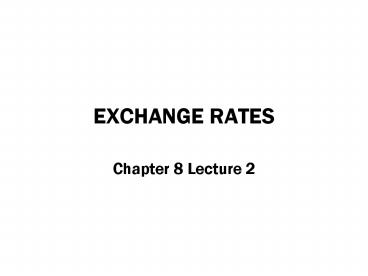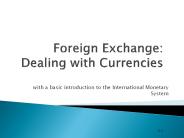EXCHANGE RATES - PowerPoint PPT Presentation
1 / 12
Title:
EXCHANGE RATES
Description:
Chapter 8 Lecture 2 EXCHANGE RATES Defined as the number of units of one currency that have to be paid to acquire a unit of another currency There are different ... – PowerPoint PPT presentation
Number of Views:95
Avg rating:3.0/5.0
Title: EXCHANGE RATES
1
EXCHANGE RATES
- Chapter 8 Lecture 2
2
EXCHANGE RATES
- Defined as the number of units of one currency
that have to be paid to acquire a unit of another
currency - There are different markets for currency
- SPOT RATE
- FORWARD RATE
- Most currency transactions are conducted by
commercial banks, and the rest by
foreign-exchange brokers
3
THE INTERNATIONAL MONETARY SYSTEM
- Efforts to provide economic stability to Allies
led to Bretton Woods agreement to fix exchange
rates based on gold and the U.S. dollar - Member currencies were denominated in gold and
U.S. dollars (because of the dollars strength in
the 1940s and 1950s) but the U.S. had 70 of gold
reserves by 1947 and governments bought and sold
dollars rather than gold assuming the U.S.
government would pay gold for dollars.
4
- Signators to International Monetary Fund in 1945
agreed to promote exchange stability, maintain
orderly exchange relationships, provide a
multilateral system of payments, create standby
reserves - Fixed exchange rates were altered in 1971
because - The U.S. trade surplus began to shrink
- U.S. dollar was devalued
- It was no longer desirable to peg the world
economy on the dollar
5
Three Exchange-Rate Approaches
- Pegged Rates
- Exchange rate is fixed to one or several other
currencies (according to a market basket of
goods) - Limited Flexibility
- Flexibility is limited to 2.25 around the US
dollar - Cooperative arrangements in EU
- More Flexible
- Can freely float
- Float on the basis of a set of indicators
6
WHAT AFFECTS EXCHANGE RATES?
- Government stability
- National or international mood or attitude
toward the country - Technical factors, e.g., economic statistics,
seasonal demands - Inflation
- In a freely floating system, the market decides
7
LOOK AT THE EFFECT OF INTERNAL INFLATION
- What is inflation? When overall demand grows
faster than overall supply, the cost of a good is
pushed up (but the value of the good is
unchanged) - If inflation cannot be stopped, then an
inflationary spiral can occur where - prices of goods rise
- so you demand an increase in earnings to keep up
- and the price of goods rises to cover the wages
organizations have to pay
8
INFLATION AFFECTS EXCHANGE RATES
- This is the concept of Purchasing Power Parity
- A change in inflation has to affect exchange
rates to keep prices in the two countries roughly
equal.
9
PPP EXAMPLE
- Two countries have an equal exchange of 1 to 1
- One economy experiences a 10 inflation rate the
other experiences a 5 inflation rate - Comparing dollar to dollar, the first dollar is
worth 5 less than the second - So, you will only buy goods from the first
country only if your dollar is 5 stronger - Hence, the new exchange rate is 1.05 of their
money for 1 of your money
10
THE HAMBURGER INDEX
- U.S. Equivalent over/under
- Norway 4.21 92
- France 2.81 28
- Japan 2.78 27
- U.S. 2.19
- U.K. 1.78 -19
- Hong Kong .97 -56
- Hungary .74 -66
- Based on 1988 data.
11
THE PPP EQUATION
- eexchange rate
- irate of inflation
- hhome country
- fforeign country
- othe base period
- tthe end of a period
12
TO PRACTICE HOW EXCHANGE RATES OPERATE
- The Big Mac Index 19958































